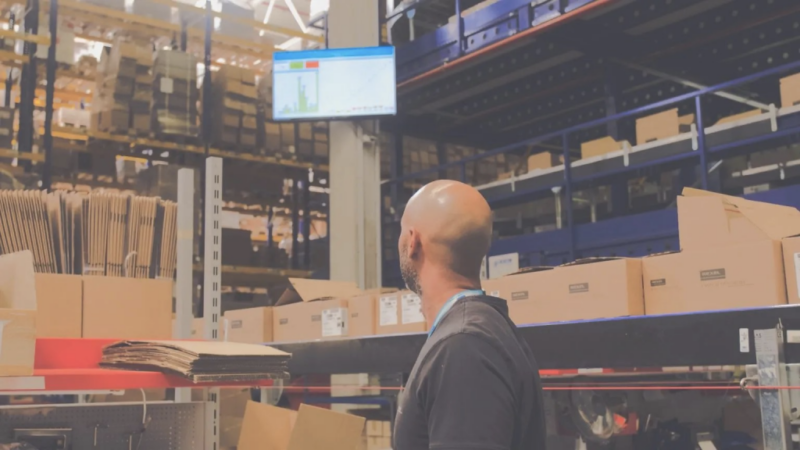
Making Shop Floor Meetings More Effective with Digital Signage
December 1, 2023 by guest author, Tomi Paajanen
Guest Post: Tomi Paajanen, ValotaLive
 In manufacturing, both front-line leaders and employees tend to spend a lot of time in various discussions to ensure everything is running smoothly. Unfortunately, this often makes everyone feel they lack time for “real work.”
In manufacturing, both front-line leaders and employees tend to spend a lot of time in various discussions to ensure everything is running smoothly. Unfortunately, this often makes everyone feel they lack time for “real work.”
A big chunk of the blame goes to ineffective shop floor meetings. Let’s look at the most common reasons as to why this happens – and how end-users can use digital signage to fix it.
Why are shop floor meetings so often ineffective – and how to fix it?
Here are three of the most common reasons why attending shop floor meetings feels like a drag:
1. No agenda and/or facilitation
Without proper facilitation, daily meetings can easily degrade into a group discussion. All of a sudden, time is up and daily meetings just get longer and longer. This also often leads to a lack of aggregated notes and conclusions.
Sound all too familiar? While digital signage can’t facilitate a meeting for you, it can definitely help you stick to your agenda and make your meetings more meaningful and productive.
Swap whiteboard for customizable display
For daily stand-up meetings that are mainly used for information sharing (e.g., at the beginning of each shift), many of our customers use software instead of paper handouts or whiteboards or rely on verbal presentation only. An app allows users to display any content (like a slide deck or simple text note, any data or graphs from BI tools, news from an intranet, and so on) on the nearest digital signage screen easily through a mobile device.
For more complex meetings, where often just the leadership is present, they can use digital signage to publish the meeting agenda in advance. This helps keep employees informed and adds transparency.
Similarly, they can easily publish key takeaways from the meeting afterward, in any format they prefer.
Using management software, users can choose to display your content on specific screens only (e.g., breakrooms only, or excluding screens that display important production data), adjust the displaying frequency based on importance (e.g., start showing two days before the meeting and don’t show meeting agenda as often as safety instructions), and more.
2. No employee involvement
In addition to the obvious improvements (like assigning different parts of the meeting to different employees, which also frees up supervisors from organizational tasks), technology can make meetings more interactive and engaging.
Turn passive screens into interactive information sources
Using software, passive info screens can become interactive displays that recipients can interact with, using their mobile phone browser. It allows users to display almost any content on info screens, in addition to pre-defined content flows (digital signage content playlists).
They can choose to show relevant production data directly from workplace tools like Power BI or Qlikview, or even zoom into graph details on the spot if display apps exist that tie in with these workplace tools. The same goes for anything from targets, records, shift schedules, or corporate news shared directly from, e.g., Sharepoint.
The best part?
Employees can easily revisit the content after a meeting on their own, which means they don’t have to spend a lot of time discussing irrelevant details during the meeting.
3. Data is not being used
The harsh truth is that business and production data is often not being used in a meaningful way.
This is typically due to delays in data processing: someone needs first to export the right data, analyze it, and finally put together a presentation with fancy graphs and visuals – and by the time they’re presenting it to the team, data is already obsolete.
This time-consuming process makes it nearly impossible to implement legitimate suggestions for improving workflows at the production line.
Skip deck-building, show data in real-time
But what if users could skip the deck-building part entirely? Software allows users to easily pull data directly from your existing workplace tools in real time. They can add any dashboards or reports as part of a content playlist, and add filters to make data more digestible for shop floor meeting attendees.
Or even better, preload content, like a Power BI dashboard. If there is a mobile component to software, that allows users to zero in on something, sing a mobile device to take control of the nearest info screen. Meeting attendees can literally see your production or business numbers refreshing in real time in front of your eyes.
This instantaneous access to real-time data empowers meeting participants to base their discussions on the latest insights, enabling more accurate analyses and prompt action.
What’s more, graphs, charts, animations, and real-time data visualization can become powerful tools for presenting information in a more digestible and engaging manner.
As Thomas Grüner, Manager WMS Tactical Board at Rexel, explains:
“Having just one centralized source for all critical data makes daily operations simpler and less prone to errors since employees don’t have to check various systems anymore manually. For example, we have one huge screen in our control tower to help our operators easily keep track of important data like open retentions and spot potential errors.”
“Probably the best thing is that when employees walk across the warehouse, they simply can’t avoid seeing those reports. This has greatly affected our productivity and the quality of our work from a customer’s point of view.”

How to use digital signage to improve overall shop floor communication
In addition to more efficient shop floor meetings, digital signage can improve your overall shop floor communication. Here are our two favorite ways to do just that:
1 – Make your factory tours visually impressive
Upload and play custom videos on any info screen during factory tours by taking control of any info screen. Users can also greet visitors with their name and company logo on the info screen and offer wayfinding services.
2 – Show content exactly where and when it’s needed
End-users can schedule content and adjust displaying frequency based on how important content is, when it was published, or where info screens are located, for instance:
- Screens near production lines can display real-time output data and the team’s daily targets and progress or customer-specific information;
- Screens in maintenance zones can show equipment status and scheduled maintenance activities;
- Screens in break rooms can show a good mix of lighter content (like employee recognition) and important news/announcements (like vacancy announcements, news shared directly from SharePoint based on, e.g., geographic location or team membership);
- Screens in generic areas can be designated for wayfinding, urgent announcements, and critical security information.
And so forth.
A digital signage content strategy dictates what content to show and where, which allows business communicators to reduce human errors and improve cost-efficiency.
A client, Rexel, noted: “We have one huge screen in our control tower to help our operators easily track important data like open retentions and spot potential errors. This makes everyone’s work so much easier.”
‘Meeting-hopping’ and unclear shop floor communication can easily eat away precious work time without yielding anything actionable, but it doesn’t have to. While digital signage isn’t a silver bullet, it’s definitely one of the most effective tools for improving your shop floor meetings and communication.
About The Writer
Tomi Paajanen is a founder and Chief Growth Officer for Valotalive, a Finnish cloud-based digital signage software platform powering employee communication, data transparency, and productivity in modern workplaces across 50 countries.



Leave a comment